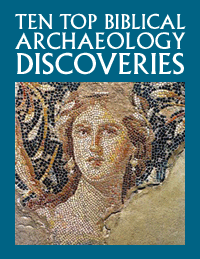The Huqoq mosaics have long been a favorite of Biblical Archaeology Review’s readers and now they have earned the title of one of National Geographic’s “100 Archaeological Treasures of the Past.” The mosaics, which adorn the late fourth-century synagogue of Huqoq in the lower eastern Galilee, are renowned for their unparalleled preservation and rich biblical imagery. With their vivid depictions of biblical scenes, including the Tower of Babel and the four beasts of Daniel 7, the Huqoq mosaics are joined on the list by such famous sites as Pompeii, Babylon, and Easter Island.

Archaeologists, led by Jodi Magness of the University of North Carolina at Chapel Hill, arrived at Huqoq in 2011, originally planning to study the date of the ancient synagogue and its surrounding village. The next season, however, they were amazed to uncover the first section of the synagogue’s mosaic. They had suspected there might be mosaics—a characteristic feature of Byzantine-era synagogues in the Galilee—but nothing could have prepared them for the unparalleled preservation they would find. While similar mosaics in the nearby synagogue at Wadi Hamam had been largely destroyed, the Huqoq mosaics were mostly intact, with nearly 75 percent of the original mosaic floor preserved.
The Biblical and Non-Biblical Images of the Huqoq Mosaic
Huqoq’s mosaics include vivid depictions of several famous biblical stories, including the Tower of Babel, Jonah and the Fish, Samson and the foxes, Noah’s ark, the Exodus, and the four beasts from the apocalyptic vision in Daniel 7. Also featured, however, are scenes that appear to originate from stories and traditions outside the Bible, including a depiction of the aftermath of a battle that involved elephants. According to Magness, who directs the Huqoq Excavation Project, this scene “appears to be the first non-biblical story ever depicted decorating an ancient synagogue.” Magness’s team has excavated around three-quarters of the Huqoq synagogue, which they believe featured mosaic floors throughout. As excavations are still ongoing, Huqoq remains closed to the public, but it is hoped that the site’s wonderful mosaics will one day be accessible to all. In the meantime, the Huqoq Excavation Project is supported by a full-time conservator, who oversees the excavation and preservation of the mosaics, as well as mosaic specialists who work with Magness to study and publish the finds.
100 Treasures of the Past

The Byzantine bathhouse at Caesarea Maritima, one of the other sites listed by National Geographic. Courtesy Nathan Steinmeyer.
According to Magness, the team was not aware of the site’s inclusion on the National Geographic list until after it was released, but Huqoq’s preservation and artistic repertoire make it an unparalleled example of ancient Jewish art. Similarly, Karen Britt, one of the project’s mosaic specialists and assistant professor of art at Northwest Missouri State University, said in a statement, “I was stunned then overjoyed and excited. It’s all the more extraordinary because some of the other sites that are in that article or on that list of 100 are places like Machu Pichu and the pyramids in Egypt, and we’re not even finished excavating.”
National Geographic’s list features famous sites and discoveries like Lascaux cave in France, Göbekli Tepe in Turkey, Stonehenge in England, and the Terracotta Warriors of China. The list includes five other sites and finds from Israel (the Tel Dan stele, the Dead Sea Scrolls, Caesarea Maritima, Masada, and the Holy Sepulchre), seven from Egypt (including the Amarna tablets and Rosetta Stone), as well as the ancient rock-cut city of Petra in Jordan.

The Monastery at Petra, one of the other sites listed by National Geographic. Courtesy Glenn Corbett.
Huqoq and the Construction of an Ancient Wonder

Aerial view of the Huqoq synagogue (with mosaics covered), after the 2019 season. Courtesy Griffin Higher Photography.
During the Byzantine period (324–634 C.E.), Huqoq, like many villages in the Galilee, was large and prosperous. Its impressive synagogue was built in the late fourth century but was in use for only a short time before being completely abandoned. Its short period of occupation, and the fact that the building was never reused or repurposed, likely account for the amazing preservation of the synagogue’s mosaics. There are also no signs that the mosaics were ever intentionally damaged during later iconoclastic episodes. Instead, the synagogue appears to have been completely and carefully cleaned out and abandoned, with no signs of later occupation. Indeed, most of the damage that is evident on the mosaics comes from the building’s later collapse. About a thousand years after the synagogue’s construction, a new building, possibly another synagogue, was built above the earlier remains, thereby covering the site’s mosaic floors and effectively preserving them until their eventual discovery.
While the Huqoq mosaics show signs of being part of larger artistic developments in the Byzantine period, they also appear to reflect a more regional style. According to Britt, “While we do not know if the mosaicists were locals, we feel certain that the same workshop that produced the Huqoq mosaics was also responsible for Wadi Hamam’s mosaics. Outside large cities, the internal evidence from the mosaics themselves and artist signatures indicate that many workshops were small family businesses that operated within a limited area, with probably some regional variation in organization and practices.”
Ed. Note: Jodi Magness and Karen Britt are members of the Editorial Advisory Board of Biblical Archaeology Review.
Read more in Bible History Daily:
Huqoq 2019: Newly Discovered 1,600-Year-Old Mosaic of the Exodus
Huqoq Mosaic Depicts Israelite Spies from Numbers 13
Huqoq 2017: Mosaics of Jonah and the Whale, the Tower of Babel and More
Huqoq 2015: New Mosaics Unearthed at Huqoq Synagogue
All-Access members, read more in the BAS Library:
Archaeological Views: A Lucky Discovery Complicates Life
Artistic Influences in Synagogue Mosaics: Putting the Huqoq Synagogue in Context
Synagogue Excavation Reveals Stunning Mosaic of Zodiac and Torah Ark
Not a BAS Library or All-Access Member yet? Join today.
The post Ancient Wonders—The Huqoq Mosaics appeared first on Biblical Archaeology Society.



0 Commentaires